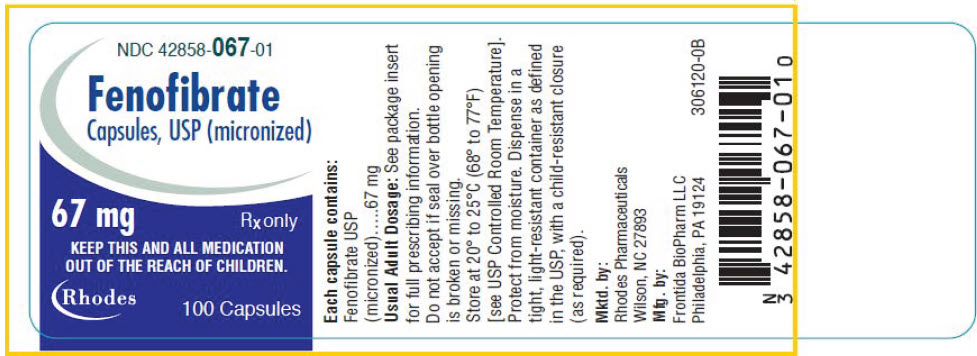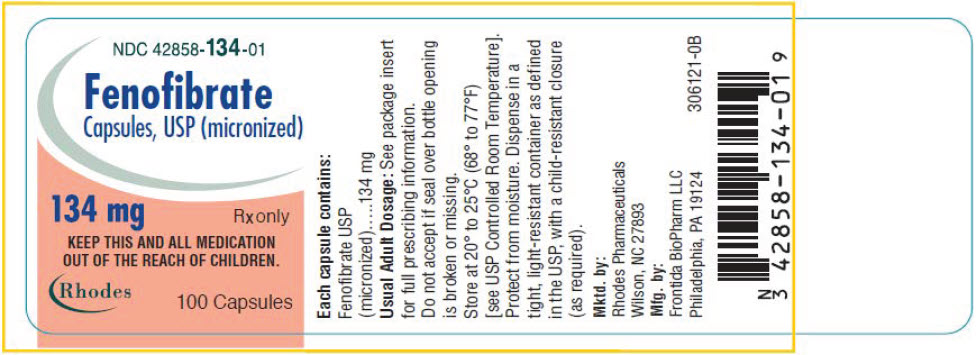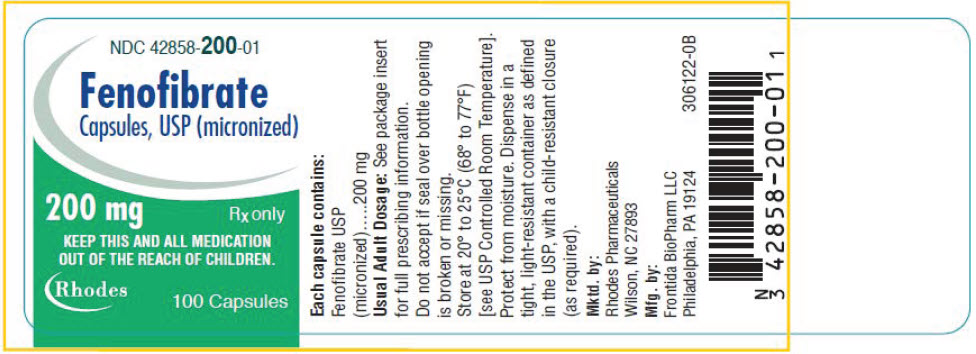Drug Catalog - Product Detail
FENOFIBRATE CAPS. 134MG CP 100
| NDC | Mfr | Size | Str | Form |
|---|---|---|---|---|
| 42858-0134-01 | RHODES PHARMACEUTICAL | 100 | 134MG | CAPSULE |
PACKAGE FILES




Generic Name
FENOFIBRATE
Substance Name
FENOFIBRATE
Product Type
HUMAN PRESCRIPTION DRUG
Route
ORAL
Application Number
ANDA075753
Description
DESCRIPTION Fenofibrate Capsules, USP (micronized) is a lipid regulating agent available as capsules for oral administration. The chemical name for fenofibrate is 2-[4-(4-chlorobenzoyl) phenoxy]-2-methyl-propanoic acid, 1-methylethyl ester with the following structural formula: The empirical formula is C 20 H 21 O 4 Cl and the molecular weight is 360.83; fenofibrate, USP is very soluble in methylene chloride; slightly soluble in alcohol; practically insoluble in water. The melting point is 79 to 82°C. Fenofibrate, USP is a white or almost white crystalline powder which is stable under ordinary conditions. Each 67 mg capsule contains the following inactive ingredients: croscarmellose sodium, crospovidone, lactose monohydrate, magnesium stearate, povidone, pregelatinized starch, sodium lauryl sulfate, talc, D&C Red #28, FD&C Blue #1, FD&C Red #40, titanium dioxide, and gelatin. Each 134 mg capsule contains the following inactive ingredients: croscarmellose sodium, crospovidone, lactose monohydrate, magnesium stearate, povidone, pregelatinized starch, sodium lauryl sulfate, talc, D&C Red #28, FD&C Blue #1, titanium dioxide, and gelatin. Each 200 mg capsule contains the following inactive ingredients: croscarmellose sodium, crospovidone, lactose monohydrate, magnesium stearate, povidone, pregelatinized starch, sodium lauryl sulfate, talc, FD&C Red #40, D&C Red #28, FDA/E172 yellow iron oxide, titanium dioxide, and gelatin. Meets USP Dissolution Test 1. Chemical Structure
How Supplied
HOW SUPPLIED Fenofibrate Capsules, USP (micronized) are supplied as follows: 67 mg - pink opaque cap and body, printed radially with "RP" on the cap and "067" on the body. NDC 42858-067-01 Bottles of 100 capsules 134 mg - light blue opaque cap and body, printed radially with "RP" on the cap and "134" on the body. NDC 42858-134-01 Bottles of 100 capsules 200 mg orange opaque cap and body, printed radially with "RP" on the cap and "200" on the body. NDC 42858-200-01 Bottles of 100 capsules STORAGE Store at 20° to 25°C (68° to 77°F) [see USP Controlled Room Temperature]. Keep out of the reach of children. Protect from moisture.
Indications & Usage
INDICATIONS AND USAGE Treatment of Hypercholesterolemia Fenofibrate Capsules, USP (micronized) is indicated as adjunctive therapy to diet for the reduction of LDL-C, total-C, triglycerides, and apo B in adult patients with primary hypercholesterolemia or mixed dyslipidemia (Fredrickson Types IIa and IIb). Lipid altering agents should be used in addition to a diet restricted in saturated fat and cholesterol when response to diet and non-pharmacological interventions alone has been inadequate (see National Cholesterol Education Program [NCEP] Treatment Guidelines, below). Treatment of Hypertriglyceridemia Fenofibrate Capsules, USP (micronized) is also indicated as adjunctive therapy to diet for treatment of adult patients with hypertriglyceridemia (Fredrickson Types IV and V hyperlipidemia). Improving glycemic control in diabetic patients showing fasting chylomicronemia will usually reduce fasting triglycerides and eliminate chylomicronemia thereby obviating the need for pharmacologic intervention. Markedly elevated levels of serum triglycerides (e.g. > 2,000 mg/dL) may increase the risk of developing pancreatitis. The effect of fenofibrate therapy on reducing this risk has not been adequately studied. Drug therapy is not indicated for patients with Type I hyperlipoproteinemia, who have elevations of chylomicrons and plasma triglycerides, but who have normal levels of very low density lipoprotein (VLDL). Inspection of plasma refrigerated for 14 hours is helpful in distinguishing Types I, IV, and V hyperlipoproteinemia 2 . The initial treatment for dyslipidemia is dietary therapy specific for the type of lipoprotein abnormality. Excess body weight and excess alcoholic intake may be important factors in hypertriglyceridemia and should be addressed prior to any drug therapy. Physical exercise can be an important ancillary measure. Diseases contributory to hyperlipidemia, such as hypothyroidism or diabetes mellitus should be looked for and adequately treated. Estrogen therapy, like thiazide diuretics and beta-blockers, is sometimes associated with massive rises in plasma triglycerides, especially in subjects with familial hypertriglyceridemia. In such cases, discontinuation of the specific etiologic agent may obviate the need for specific drug therapy of hypertriglyceridemia. The use of drugs should be considered only when reasonable attempts have been made to obtain satisfactory results with non-drug methods. If the decision is made to use drugs, the patient should be instructed that this does not reduce the importance of adhering to diet (see WARNINGS and PRECAUTIONS ). Fredrickson Classification of Hyperlipoproteinemias Lipid Elevation Type Lipoprotein Elevated Major Minor C = cholesterol TG = triglycerides LDL = low density lipoprotein VLDL = very low density lipoprotein IDL = intermediate density lipoprotein I (rare) Chylomicrons TG ↑ ↔ C IIa LDL C — IIb LDL, VLDL C TG III (rare) IDL C, TG — IV VLDL TG ↑ ↔ C V (rare) Chylomicrons, VLDL TG ↑ ↔ The NCEP Treatment Guidelines Definite Atherosclerotic Disease Coronary heart disease or peripheral vascular disease (including symptomatic carotid artery disease). Two or More Other Risk Factors Other risk factors for coronary heart disease ( CHD) include: age (males: ≥45 years; females: ≥55 years or premature menopause without estrogen replacement therapy); family history of premature CHD; current cigarette smoking; hypertension; confirmed HDL-C <35 mg/dL (<0.91 mmol/L); and diabetes mellitus. Subtract I risk factor if HDL-C is ≥60 mg/dL (≥1.6 mmol/L). LDL-Cholesterol mg/dL (mmol/L) Initiation Level Goal No No ≥190 ( ≥4.9) < 160 (<4.1) No Yes ≥160 ( ≥4.1) < 130 (<3.4) Yes Yes or No ≥130 In CHD patients with LDL-C levels 100 to 129 mg/dL, the physician should exercise clinical judgment in deciding whether to initiate drug treatment. ( ≥3.4) < 100 (<2.6)
Dosage and Administration
DOSAGE AND ADMINISTRATION Patients should be placed on an appropriate lipid-lowering diet before receiving fenofibrate capsules (micronized) and should continue this diet during treatment with fenofibrate capsules (micronized). Fenofibrate capsules (micronized) should be given with meals, thereby optimizing the bioavailability of the medication. For the treatment of adult patients with primary hypercholesterolemia or mixed hyperlipidemia, the initial dose of fenofibrate capsules (micronized) is 200 mg per day. For adult patients with hypertriglyceridemia, the initial dose is 67 to 200 mg per day.Dosage should be individualized according to patient response and should be adjusted if necessary following repeat lipid determinations at 4 to 8 week intervals. The maximum dose is 200 mg per day. Treatment with fenofibrate capsules (micronized) should be initiated at a dose of 67 mg/day in patients having impaired renal function, and increased only after evaluation of the effects on renal function and lipid levels at this dose. In the elderly, the initial dose should likewise be limited to 67 mg/day. Lipid levels should be monitored periodically and consideration should be given to reducing the dosage of fenofibrate capsules (micronized) if lipid levels fall significantly below the targeted range.
